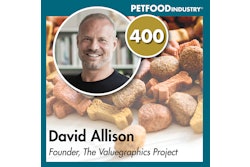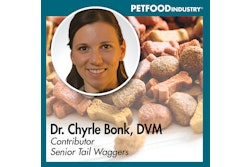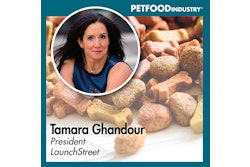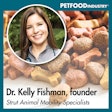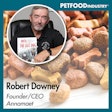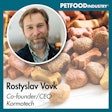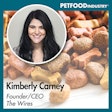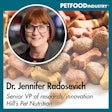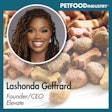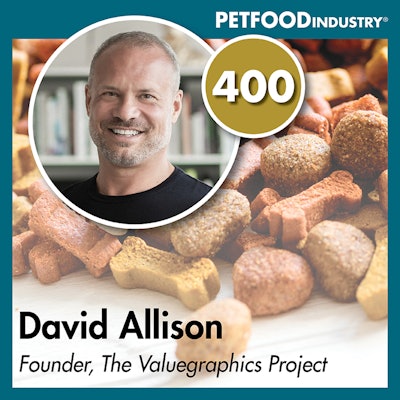
What do pet parents value the most? And how can you tap into those values to create a better experience for your customers? Lindsay Beaton, host of Trending: Pet Food, and David Allison, global values leader, human behavior expert and founder of The Valuegraphics Project, dive deep into the subject during this episode that asks, "How do we take consumer-driven insight and use it to best serve pet owners?"
The below transcript is from Episode 37 of the Trending: Pet Food podcast, where host Lindsay Beaton spoke with David Allison, founder of The Valuegraphics Project. The two delve into the values pet food customers hold dear and how your business can tap into that for a better customer relationship. You can find the episode at Trending: Pet Food Podcast, on SoundCloud or on your favorite podcast platform. This episode originally aired in June 2023.
Lindsay Beaton – Editor, Petfood Industry magazine and Host, Trending: Pet Food podcast: Hello and welcome to trending pet food the industry podcast where we cover all the latest hot topics and trends in pet food. I'm your host and editor of pet food industry magazine, Lindsay Beaton, and for today's episode we're going to do something we haven't done before: a follow-up.
I'm here with David Allison, global values leader, human behavior expert and founder of The Valuegraphics Project. He was the keynote speaker at Petfood Forum 2023, where he talked about what Valuegraphics can tell you about your pet food consumers. I also spoke with him prior to Forum in Episode 31 of this podcast about The Valuegraphics Project.
Today, we're going to dive into some of the results of a pet industry specific survey he presented at Petfood Forum. And there will be a little action item at the end of our conversation, so make sure you stick around. Hi, David, and welcome back.
David Allison, founder of The Valuegraphics Project: Hi, thanks for having me back. It's so exciting to be here again.
Beaton: Now, I introduced David in Episode 31. But in case you haven't tuned into that episode, which you should, here are the highlights. He launched The Valuegraphics Project to create the first accurate inventory of core human values for everyone on Earth.
After 750,000 surveys in 152 languages, the project has resulted in a complete directory of human decision-making allowing organizations to connect with people in new, more profound ways by honoring what they value.
Now that David has presented his pet specific research at Forum, I wanted to bring him back today to answer this question. How do we take this extra level of consumer insight and use it to best serve pet owners?
I want to begin our conversation by jumping off of something that you began your presentation at Petfood Forum with. You pointed out that we all want some people to do something, and this is especially true when it comes to business as an industry. We want people to buy food and treats and supplements for their pets. How do value graphics feed into that idea?
Allison: That's a great question. It's a fascinating and kind of unifying thing when you think about it that everybody, no matter what you do, whether you're in the pet food industry or not -- and even within the pet food industry -- no matter what it is you're doing in the pet food industry, we're all just trying to get some people to say “yes” to something we want them to say “yes” to.
We're all in the same business, when you think about it, from that macro level. Getting people to say “yes,” getting people to make a decision you'd like them to make, is about understanding how human brains make decisions. There's been a bazillion smart, smart scientists around the world trying to figure this out for decades now. They all fall under the umbrella of behavioral science. You could talk to psychiatrists, psychologists, sociologists, neurologists, all these different people, and they would all -- just between us probably fight like cats and dogs about most things -- but they all do have one thing that they agree on -- one big macro idea, which is that it’s our values that drive every decision that we make.
We don't have enough time to go into all those different fields of science, but maybe I'll just quickly recap neurology because it's one of my favorite ways of looking at this, because it's about biology. This is about how our brains are wired. We don't really have any choice in this matter. Inside your prefrontal cortex is a little tiny piece called the insula. The insula’s only job is to filter all the incoming data, which for your brain is sights, sounds, smells, ideas and past experiences -- everything it can get its hands on, and say, “Okay, well, if that's the situation, we're going to behave this way, we're going to make this decision, not that decision.”
Your insula uses one set of filters to make those calls on your behalf – that’s your values. If something comes along that is aligned with your values, your insula will incent you to get that thing. The insula will say, “Listen, one of our values in our life is family, and something's just come along that's really going to be great for family. Therefore, we need to go get that.” It issues orders to the rest of your system and says, “Listen, go get that thing.” When you do, your incentive is going to make you feel happy or make you feel good. That's your incentive, that's a reward for going to get that thing, choosing that thing, making that decision.
If something comes along that might be bad for family, there's also a set of incentives, but those kick in right away. It's “Get that thing away from us, and until you do, you're going to feel anxious or afraid or upset.” You're going to feel bad – “I'm going to make you feel bad until you make that thing go away.”
In a very real way, no one listening today, no one on Earth, no human has a choice. Our brains are hardwired to go after the stuff that we value and run away from anything that might harm what we value. That’s just a biological truth.
So Valuegraphics. What we've done with all this research is, we've profiled people from all around the world, and we've created an inventory that's more accurate on what everyone's values are. We can now use this as a set of insights to understand different groups of people and say, “This group of people, they're running towards this thing, and they're running away from that thing.” Now we don't have to think about them in the other ways that we have always thought about them in the past, which is based on ridiculous labels like gender, age and income and that kind of stuff.
Beaton: It sounds a lot like we're taking the human experience and trying to organize it a little bit in a way that everybody can look at the data and gain some insights into their selves, gain some insights into everybody around them. Then we can take that knowledge and use it to broaden our ability to interact with humanity, which is what business is, after all -- you are interacting with humanity in some very specific ways to achieve some very specific results.
One of the most interesting things about your presentation at Forum was that you identified five key values that seem to appear among pet food shoppers, and they appear among these pet owners in higher levels than in the general population. There were three that were much more prominent in pet owners than there were in the general population, so I want to talk about those first. Those three were personal responsibility, trustworthiness and experiences.
Now, on a top level, all of these make quite a bit of sense. But I want to really dive into what that means for this population, and what it can mean for people trying to market to this population. So how do these values play into understanding pet owners and how they operate?
Allison: If you take that and layer it back on the conversation, we just had a moment ago about your insula, pet owners, more than the general population, are waking up every day trying to find anything that aligns with the importance they place on the value of personal responsibility, trustworthiness and experiences. It's like their GPS system. You now have three points on their GPS system. You know what way they're going to swim towards as a school of fish -- they're all going to swim in a particular direction. If that direction has some personal responsibility, trustworthiness and experiences at the end of that path, the school of fish is going to turn in that direction.
Like all things that have to do with human behavior, however, we're not that simple. Moving humans are complex and hard to understand, because our values mean different things to different people.
It's not one of the values we're talking about today, but for just as an example, because I have the numbers in my head, belonging is another value that shows up in the 56 values that we've mapped for the world. In the United States of America, it's the number one most important value. And there's 912 kinds of belonging that we have codes for in the database. When people talk about feeling belonging, there's all these different ways that it comes out and manifests in their life.
For each of these three values, we are talking about personal responsibility, trustworthiness and experiences, there's a particular meaning in place for pet food shoppers -- maybe that's a good place to start. Let's put two of them together: personal responsibility and trustworthiness. They kind of go hand in hand once you start looking at the meaning behind those two values. You'll see why as I explain this.
Personal responsibility, the kind of personal responsibility, the meaning for pet food shoppers, these are folks who are really, really interested in understanding everything about everything. They’re research junkies. Personal responsibility is about wanting to be the person who makes stuff happen, who is the decider, who pushes the needle in the right direction -- they want to be personally responsible. The way that manifests is reading as much as they possibly can; understanding as much as they can.
I have friends who, when it's time to buy a car, it's a yearlong process to buy a car, because they have to study EVERY car that's on the market before they're going to be willing to actually go. Which is so not me. I'm going to just like, “Oh, that's a nice one. That'll do for the next few years. Off we go. That's the car for me.” These are research junkies, and they're looking at things from a very long-term perspective. That's personal responsibility.
The other value is trustworthiness. The kind of trustworthiness they're looking for is they want to be seen as problem-solvers. You can see why I've put these two together, right? They want to get their values in alignment around being trustworthy. They want to be the one who solves the problem, which sounds a lot like personal responsibility to me. They want to be the one who moves the needle in the right direction. To move the needle in the right direction, they're heavy-duty researchers.
If you put them together -- and to make this a little bit more colloquial -- these pet parents, pet food shoppers, they're research junkies and they want to solve problems.
If we know that as a truth about pet food shoppers, what do we do with it? What are some of the things that the industry could start to focus on now that we know that? When I was speaking, the one that immediately came to mind is functional ingredients. I know it's been a huge focus in the pet food industry for a very long time, but this is the data proof that this is the right direction to go deeper and bigger and broader. The more functional ingredients you can offer, the more it gives people the ability to know more stuff and feed that research need that they have and allow them to be the decider. “My pet needs this. That functional ingredient is the one for me.” It gives them a whole menu of buttons that they can push and decide which ones are the ones that my pet needs right now.
Beaton: What do you think is the line between insight and data? What I mean by that is -- so we know that functional ingredients, for example, are continuing to grow in the space. Pet owners are doing more research. They are becoming more and more interested in the health and wellness of their pets, preventive maintenance, in acute maintenance, all these things. We can see that from a data perspective, the functional ingredient trend is growing and building up in revenue and things like that. When you put this kind of insight alongside it, you understand why it's happening, like you're able to get into consumers’ brains and be like, “Okay, this is a thing that's happening. But really, why is it happening?” Well, it's happening because of their desire for personal responsibility and their solutions focused. How often do values and actions merge so cleanly? Or is it a lot more complex than that?
Allison: It can be more complex. But you know, a lot of times what we end up discovering when we do this is the why. As you've said so beautifully, why is stuff happening? Nobody in the pet food industry worth their salt is going to deny that functional ingredients are a big trend and has been and will continue to be. But now that we know “why,” we can dive a little deeper in particular ways that will help with whatever objective you're trying to reach.
I don't ever pretend to know the industries I'm speaking in as well as the people in the industry. So sometimes the stuff I suggest comes across as being perhaps a little bit not possible or a little bit “blue sky thinking.” But that's okay, because all I'm trying to do is get people to start using values as a way to figure stuff out. “Take what I'm about to say and use it with your own lens and see, David, that's not going to work.” But now you've been given the idea, “This could work.”
That's the goal here -- since we have research junkies who want to solve problems, why not give them some sort of training? Why not make it possible for them to know more than the other pet food shoppers they meet while they're out walking their dogs or hanging out at a dinner party and talking about what kind of cat food they're buying, or whatever it is they might be doing? Why not give them a certificate program that they can sign up for or learning on-demand modules where they can understand what the scientists who are creating those functional ingredients know? Why not have those scientists get on video and say, “Hey, we just added something-or-other. Here's why, what led to it, the research behind it, why it's great, and how it's going to help your pet.” That person is going to just eat that up. They're going to love knowing that level of detail because they’re research junkies who are trying to solve problems and want to be the problem solver and the solution provider. Give that to them in a way that makes it fun as well as being on brand and all those sorts of things.
One of the things I noticed about the pet food industry, so many brands that I looked at getting ready for this keynote are talking about these amazing leaps forward in nutritional science, but they don't ever really tell you much about it. It's just a one liner on the homepage of the website, or it's a one liner on the front of the product on a shelf. There's no detail. I think maybe there's this assumption that yeah, we got the smart scientists thinking about all that stuff. You guys don't need to worry yourselves, but they want to want to be worried about that.
Make the scientists into the heroes. Pull that stuff up to the front of the website. Don't bury it. You spent a lot of time and money and smart, smart people figuring this stuff out. Share it – they will lap it up. They really, really are interested in these things. It makes them the decider that they want to be.
Beaton: This might be going off into the weeds a little bit, but because we're merging personal values and business, I feel that it's an important thing to address. How do you take insights like this and apply them to your business without coming off as being disingenuous or being manipulative? One of the other hallmarks of pet owners these days, and I think consumers in general, is that we're becoming savvier to BS. Basically, if a company is talking the talk, but not walking the walk, it's easy to find out. It's easy to spot and people are not having it anymore. They're calling people out. So when you're talking about gaining insights into people at this level, how do you apply that without coming across as being the bad guy? “How dare you get in my head to try to manipulate me!” How do you stay on the right side of being a trustworthy business? One of the other things we're going to be talking about in a minute is loyalty and how much stock pet owners put in that value. So, how do you not lose them?
Allison: What you must do is come at this in a very open and honest and transparent way. Here's the thing -- some group of people inside every pet food company in the world is going to come together and make some decisions about what you're going to talk about and what you're going to do. Isn't it more authentic and transparent to just focus on the stuff that you know people really care about? You don't have to call it out and say, “We're doing this because we had some insight information on what makes your brains work.” But to just sit back and say, “Well, how else could we decide?” You know how else you would probably decide is based on demographics. You would probably say to yourself, “Well, our pet food shoppers are between this age and this age, and they make this much money, and they live in this part of the world. Therefore, we're going to use some big giant stereotypes to figure out what these people will like.”
Instead, why not just know what they care about and use that as a filtering mechanism to figure out how to drive the ship? I made a brief reference a moment ago to a school of fish, but it's very much that. What we're providing here, and what we've figured out for pet food shoppers is, this school of fish is going to twist and turn in the ocean as it swims around. If you know what they're twisting and turning for, why they're going to go in one direction versus another, and you can be the thing they swim towards, isn't that a more human and honest thing to do than just make stuff up and hope it sticks? Which is kind of what we're all doing right now. We all just sit around and say, “My target audience is 73% female.” Cool. So what are you going to do with that? Are you going to make everything pink? You just make stuff up. Oh, it's all Gen Z and you know, Gen Z's, they are all like -- fill in the blank with a ridiculous idea here. But they don’t! “All Gen Z” do not like anything! That's impossible. There are tens of millions of them in the United States alone, and you're trying to tell me they're all going to respond in the same way. Of course, they're not. Anybody who's feeling like this might come across as slightly Machiavellian, it's not that at all. It's just saying, listen, as an organization, if you truly believe that you're here to make products that people want, care about, and love -- why not find out what they want, care about and love, and give them that?
Beaton: Two of the other top values that you identified for pet food shoppers, I feel are a little more complex: loyalty and security. Now, I feel like those really get to the heart of a lot of humanity. They were top values for the general population overall, and they seem to be heightened in pet owners. What kind of insights do these two values give us when it comes to pet food shoppers?
Allison: This is a good moment to pause and refresh everyone's memory that there are 56 values that could have shown up. While some of these words seem like they're very broad -- of course, everybody wants to feel secure -- not everybody values it enough as a value for it to show up in every profile.
Words like “loyalty” and “security,” when you drill down and get into what they mean to this group of people -- this is very precise to this audience. You may have suspected these things were driving people anyway, and it may not be much of a lightbulb moment for you, but the light bulb moment is for sure -- with more accuracy than you need for a PhD from Harvard – that these are the drivers of all the potential drivers. These are them.
Let's dive into your question -- loyalty and security.
Loyalty for pet food shoppers is one of those funny values. There's a couple of them we refer to as “reciprocal values.” The thing about reciprocal values like loyalty is you must be loyal first, then people will be loyal to you. Many companies do this backwards. Think about every airline out there. You show a lot of loyalty to them, then they'll put you in the little lounge and feed you pastries before your flight. If they really wanted loyalty to work, they would find a way to show loyalty to the consumer first, then watch the outpouring of loyalty that comes back to them.
The kind of loyalty that pet food shoppers are looking for is about existing relationships. It's not to brands, it's not to everybody. There are all kinds of different loyalty, hundreds of different versions of it, but the one for pet food shoppers, loyalty towards existing relationships. So hold that thought.
Let's look at what that could mean in a pet food context. I thought an interesting thing would be to lean into regional, if not even local, flavors. I'm loyal to where I live. I'm a proud citizen of the Pacific Northwest. I have loyalty to the places that I've chosen to call “home.” That's an existing relationship I have. Using that existing relationship and saying to people, “That's great. We love that you love the Pacific Northwest. Here's some pet food that's inspired by all the amazing flavors and cuisines of the Pacific Northwest.” That's going to give people that dose of loyalty that they're looking for around existing relationships.
Just think about the beautiful kinds of foods that are available around the world -- just big ones like a Southern comfort flavor, a Texas barbecue, a Creole flavor. We all kinds of different things that you could do to help people find the food that best reflects their importance they place on that value of existing relationships.
Beaton: Does that kind of relationship loyalty extend to philanthropic efforts? That is something a lot of industries are involved in, but for the pet industry, it's pretty much a slam dunk. If you want to gain the loyalty of your consumers, take care of the animals, because we all have animals, and we all want to help them. Can that be something that touches on the loyalty aspect?
Allison: It occurs to me there's a bunch of companies who have done this quite well. I'm not sure of any in the pet food industry specifically. Maybe there are some, and if there are, I'd love to hear from you. I'd love to know about it.
As an audience of people, pet food shoppers/pet parents, who, as you say, are very, very concerned with animals -- we all love animals -- we probably already have some way we're doing this in our life. We're probably already donating to a local animal shelter or a rescue operation. So instead of being the corporation who says, “Every time you buy some of our pet food, we're going to donate to a place we like.” Why not flip it around and let people be loyal to their existing relationships? “Every time you buy something from us, we're going to donate to an organization that you like. One that you already have that existing relationship to.” Because now, not only is some money – and it doesn’t always have to be money either, it could be other things too – but some support is going to an organization that they have an existing relationship with. They now get to be the people who are responsible for that personal responsibility. They just got to move that other value needle in the right direction as well, to kind of get a twofer. In that case, you're hitting some existing relationship – loyalty -- and you're helping them feel like they're the ones who made something good happen for an organization that they already care about.
I've seen this in limited ways. I think I'll say the word that we're not supposed to say around retailers, but Amazon does some things where you can choose from a list of five or six different organizations on how you would like some money to be donated. But why does it even have to be those five or six? Why can't it just be whoever you want, just give us an address. Maybe this is something we can only do with our VIP customers, because it's just too unruly to think about doing it with everybody who buys one tin of dog food in the store. Maybe it's the ones who are signed up for our loyalty program, they're on our mailing list, they're part of our CRM system. And part of signing up to be part of our system is you tell us the information about an organization you'd like to support. As your purchases are being tracked, we will make sure the funds are going to those folks. Again, back to my disclaimer, it may be an unruly thing to execute. But I hope it sparks some ideas from people who know more about the pet food industry than I do and makes them say, “That's not going to work, but what we could do is this.”
Beaton: So where does the idea of security come into play? What does that mean to pet owners?
Allison: Again, we'll go into the meaning for pet owners around the value of security. This is a kind of generalized meaning -- it's all aspects of their life. They're not only concerned about being secure in one part of their life or another or in one realm versus another. It's about emotional security. It's about security of my home. It's about physical security, everything. I just want everything to be secure.
Another way to think about it is these are people who don't really like a lot of surprises. I just want to know everything's going to be okay. Everything is going to be okay. It's a bit of a reframing for people in the pet food industry, that part of what you're contributing to, for these folks, is stability in their life. You're not really in the pet food business, you're in the life stability business. You're here to help them feel like their life is really, really stable.
It's a great way to start thinking about brand extensions. What else, beyond pet food, can you offer to help them feel more stable in more parts of their life? Can you offer therapy sessions for people who are having a really hard time with a difficult new pet who's just not taken to the training and not doing what they need to fit in with other pets in the household? Can you give them a 1-800 number to call and find out what to do to bring some stability back? Could you think about going into pharma or an insurance business? What else can you do that offers people stability. They already trust you with the nutritional needs of their pet, so you have their trust. How else can you help them with other things that would leverage that trust and give them that security, that life stability, that they're looking for?
Beaton: We're talking about a lot of big ideas, but I don't want to ignore my small- to medium-size business listeners who might not have the resources to do some of these huge things that we're talking about. But solutions don't always have to be huge. I know you work with a lot of different industries and there are a lot of companies who have adapted Valuegraphics and made it part of their business strategy. Are there any successes you've seen that come on the smaller end of things?
Allison: You know what? This stuff works, regardless of whether we're talking B2B, or B2C. One of the things I learned touring Petfood Forum was that there's a whole lot of companies who are selling to other companies inside this industry. So B2B or B2C, the size of the issue you're trying to solve for doesn't really matter. It can be a simple thing, like, what should my email signature say? How do I answer the phone when somebody calls the customer service line? Who should I hire to interface with my retailers?
Let's take it to every company on Earth. Everyone -- I'm sure there's a rare exception out there -- is trying to do something on social media these days. What should you talk about? Let’s stick on security, for example. If you know that security and stability is something that people want to hear about -- what kind of stories have you got for them about what you're doing to make sure that your food is secure, your ingredients are the best they can be, and there's never going to be any kind of issue around food security or ingredients stability or quality around your product?
Could you have an email campaign that you send to your mailing list to talk to about some of these things? Here's some more research on our new functional ingredient written up for you in a quick little paragraph. Maybe there's a video I can click on and listen to one of the scientists responsible. It can even link out to someone else's information about that functional ingredient that is being distributed to many pet food manufacturers, but you're the one who's taking the time to send it out in your email newsletter to your subscribers. Explain, here's some more links that can help you understand what these ingredients are all about in our pet food. It doesn't have to be your original content. Be the curator. Help them find the stuff they're looking for.
Often when we're working with a company and we get to this point, the next step in our process is to take them through what we call a” values thinking workshop,” where we show them how to connect the dots from these values to whatever it is they're trying to solve. During that little workshop, we're never going to solve any of the big problems. We have an example or two that we like to use to help people see how easy it is to use this stuff to solve any problem. One of the examples that we use that I love is, “Okay, imagine you're bringing all your best customers together for an event of some sort. What would you tell the caterers to bring?” Because it's fun, and it's light, and nobody thinks they're like solving the problems of the world or setting the organization on a different track.
What would you tell the caterers to bring if you know that personal responsibility is a big deal and that these folks are research junkies that like to be the decision makers. You might say every ingredient needs to have a whole lot of information on the buffet that you're putting out there, they're going to want to know what this stuff is. Don't you dare make the food for them, let them make the food. It's going to be an assembly – this is make your own pizza. You're going to be the person responsible around here. We've told you what all these ingredients are, and you get to be the personally responsible one. The security value that we just finished talking about comes in because all the people can visibly see that there's protection. There are sneeze guards in place, and everybody's wearing rubber gloves. It's very, very secure. This food is all very secure and stable. There isn't going to be any surprises that come out of participating in our big lunch.
Even something silly, like what do you tell the caterers to bring to a customer meal? What are you going to send people as a thank-you gift? So let's say you have a VIP program. You’ve signed up some ambassadors. Those folks need to hear from you every now and then with a little, “Hey, thanks for being our one of our ambassadors!” Send them something that has to do with some of these values. Even the tiniest little decisions, because you know what, if you add up enough of those tiny, little decisions … add one line of texts to your packaging that rings a bell around a value, tell one story in your social media in a more prominent way than you otherwise would, sign off your emails in a way that's more aligned with values … just add up enough of those tiny little changes, and what you end up with is a whole lot of values being used as a way to tell people, “I got you. I know who you are. I know what you care about, and I'm doing my best to give that to you.”
Beaton: I think that segues very nicely into the last thing I want to talk to you about. This is the second episode of the podcast you've been on. I listened to you at Petfood Forum. One of the things that most speaks to me as a human being about this is we've been talking about Valuegraphics and their application to businesses and how to better understand your consumers. But what Valuegraphics seems to come down to is just looking at people differently. Understanding where they're coming from and meeting them where they're at, which is something we should be doing in a broader, more human sense that has nothing to do with business, and everything to do with human relationships. How can we make sure we are treating people the proper way and living our best lives and helping everybody else live their best lives as well. So, I want to talk a little bit about how the idea of Valuegraphics -- the ideas behind Valuegraphics -- can help serve us. Not in business, because we've already been talking about that, but overall in life. How can we as humans apply these lessons that you've learned in Valuegraphics to just become better people?
Allison: This is my favorite part of all these conversations. This is where my heart starts to swell up a little bit. Because, like you said, we've talked about how this can help with business. I'll drop a couple of stats here. It's eight times more effective to target a group of people based on their values compared to what we do now, which is demographics and a little bit of psychographic past sales information. Eight X to your budget, your effectiveness, whatever you're doing. People tell us they'll be willing to pay as much as 12% more for things that align with their values, so there’s a real good reason to do this. They'll trust you as much as 20% more. They’ll be more engaged with a community or a workplace as much as 40% more if they just feel like they're in alignment with their values.
There are all kinds of good, hardcore reasons to do this, all of which are eclipsed by the real reason, which you've alluded to -- that we need to do this. The longer we keep using the old-fashioned ways of thinking about people -- of labeling people based on age, gender, income, marital status, number of kids, all those labels we're all familiar with that we use in our boardrooms every single day -- the more we're signaling to ourselves and the people around us that's the correct way to think about people. We're faced with a new group of people we're trying to understand. Suddenly we say to ourselves, “Well they're 73% female, they make $100,000 a year, they have a college education.” We just throw all those labels on them. We stand back and think we know who those people really are, and we don't. We only know what they are.
Pretending that we know who they are because of those labels leads us to use stereotypes about them. “Our audience is 73% women, therefore, we have to do something with this. Let's make things pink. Let's choose cursive texts.” It sounds ridiculous to say that, but just take one step into the toy store and look at the pink toys and the blue toys. You can see that it's happening all around us every single day. It's ineffective and doesn't work. It's perpetuating stereotypes about who people are.
Those stereotypes -- those are the problem. They are fuel for the fires of racism and ageism and sexism and homophobia and classism, and all these other things that are the social movements we are grappling with. And I have to say, not so successfully in many parts of the world. They're all there, in part, because we insist on looking at people with demographic goggles and saying, “Well, there's a whole lot of gay people over there, and we all know what gay people are like. Let's start treating them like a group of people that we all know what they're all about, and enacting laws and being discriminatory and doing all the things that we're going to do. Because wow, those people, they're all like that.” It's just not the case.
My hope is that by helping businesses make more money, because that's what businesses like to do, and by using data to get there -- because let's face it, data is the love language of every business, that's how they want to talk to themselves and to each other -- perhaps that will change the narrative around how we look at each other. If we can start looking at each other in a different way, if we just change the way we look at ourselves, change the way we look at other people, and change the way we think about each other, we can in a very real, concrete way, change the world. I know that sounds like a big claim, and everybody's making it. You know, I'm pretty sure the potato chips I ate last night said, “these potato chips will change the world.” I mean this though in a much more realistic way. It won't happen overnight. It'll be incremental, but slowly and surely, if we all just give our heads a shake and think about each other based on what's on the inside instead of what's on the outside, we'll build a much less divisive, much better, happier world.
Beaton: I think that is an excellent message. My favorite part of this entire Valuegraphics umbrella is that you started this because you wanted to understand people better, and we can apply it to business. But business is made up of people as well, so if you can internalize this from a business perspective, perhaps you can internalize it from a human perspective as well. Then everybody wins -- businesses win, consumers win, humans win.
Allison: Absolutely. If I can end with a request. There's something everybody listening today can do to help me out. If you use any of this information … if you use these values of personal responsibility, trustworthiness experiences, loyalty and security … if you use those in some way, even small ways, to change something, even a small thing, about what you're doing, I'd love to know the story.
As a speaker, a writer and a researcher, we throw this stuff out into the universe and say, here's some really cool, useful information. We very rarely get the stories back about, “Oh, we did that thing, this happened, and it was great.” If anyone has stories about how these values have helped them, I would be eternally grateful. Of course, I would, with their permission, share it all over the place, so there's something in it for them too. It would really help a lot.
Beaton: If people do want to share their stories with you, how might they do that?
Allison: The easiest way is probably on LinkedIn. I'm hard to miss. We're active there. If you want to go to my website, there's buttons there you can push to allow you to send an email or other options. There's valuegraphics.com. My public speaking website is slightly different. It's davidallisoninc.com. So, the research company is valuegraphics.com, and my personal site for speaking and writing is davidallisoninc.com. All of them have “contact us buttons.” I'd love to hear from anyone who's got some story to tell.
Beaton: Perfect. That’s it for this episode of Trending: Pet Food. You can find us on PetfoodIndustry.com, SoundCloud or your favorite podcast platform. You can also follow us on Instagram, @trendingpetfoodpodcast. And if you want to chat or have any feedback, or if you have stories that you would like to tell and make sure we get to David, we can do that as well. I'd love to hear from you. Feel free to drop me an email: [email protected]. Once again, I'm Lindsay Beaton, your host and editor of Petfood Industry magazine, and we'll talk to you next time. Thanks for tuning in!



